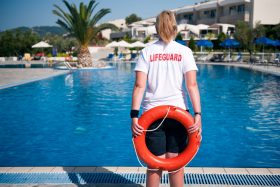Lifeguard Safety Tips for Teens

When teens get their first jobs, it often falls into one of a few common categories, like restaurant employee, retail employee, and babysitter. Back in the old days, you could include newspaper delivery on that list. But another popular option for teens looking to earn some extra money is by working as a lifeguard at a local pool or beach.
Being a lifeguard is all about putting safety first. It’s up to lifeguards to warn people against dangerous behavior, like running next to the pool. If anyone gets into trouble while in the water, a lifeguard can jump in and save them. But while safety is a top priority while working as a lifeguard, who protects the lifeguards?
Lifeguards face several dangers while on the job. Not only are there dangers that come if they need to get into the water, there are other risks like heat-related illnesses and slip-and-fall accidents. But one issue that many teens don’t often think about is workplace safety and aren’t aware of their rights when it comes to having a safe environment to work in.
Even when jobs are traditionally seen as risky and dangerous, that doesn’t mean employers are fully off the hook when it comes to preventing injuries. There are often safety measures like protocols that can be put into place and equipment that can be used to help reduce the risk of people getting injured on the job and employers have a responsibility to provide an environment that isn’t unnecessarily dangerous. But since teens are new to the workforce, they might not feel comfortable speaking up about an unsafe condition they see in the workplace. If you have a teen who is starting a job as a lifeguard, make sure to talk to them about some key safety issues to be aware of.
Sun & Heat Protection
Unless a pool is indoors, lifeguards are likely spending much of their time working in the sun on some of the hottest days of the year. Because of this, it’s crucial that lifeguards be provided with adequate opportunities to cool off and protect themselves from the sun. This can include basic measures like employers providing shaded areas where lifeguards can cool off, but it can also include maintaining adequate staffing levels so that lifeguards can take regular breaks. Yes, it’s important to maintain constant watch over what’s happening around the water, but it’s also important for lifeguards to not spend too much time working in high temperatures without breaks. Having an appropriate amount of lifeguards on duty can help everyone stay safe.
Staying hydrated is also essential on hot days. And even if it isn’t hot out, regularly applying sunscreen and wearing sunglasses are basic steps for sun protection. Sunburn can be uncomfortable enough to deal with when it happens, but prolonged sun exposure over time can potentially result in skin cancer, other types of skin damage, and damage to eyes. Remember, even on days when it doesn’t seem particularly sunny, it’s still possible to get sunburned.
Environmental Safety
Aside from the heat and sun, there are other issues related to the elements that can cause problems for lifeguards. For example, in an indoor pool, it’s important for the space to be properly ventilated because of the use of chlorine and other chemicals in the water. And at outdoor pools and beaches, there are weather-related dangers to plan for. For example, do lifeguards have a safe place to go if a thunderstorm rolls in?
Fall Prevention
Anytime you have water being near a hard surface on the ground, there’s going to be a risk for slip and fall accidents. This is why slip and falls are so common in places like kitchens, shipyards, and, of course, around pools. For lifeguards, a good slip-and-fall prevention measure is wearing water shoes with non-slip soles. With people splashing around and getting in and out of the pool, it’s inevitable that the area surrounding the pool will get wet and these types of shoes can help prevent falls. For lifeguards at places like beaches, water shoes will help protect lifeguards if they step on something sharp while trying to get into the water.
Another way lifeguards can potentially fall is by getting on and off of the lifeguard stand. The elevated height of a lifeguard stand helps them better keep an eye on the water, but being at a height inherently increases the chances of falling, so it’s important for lifeguards to be trained on how to safely climb on and off of the lifeguard stand.
Getting In & Out of the Water Safely
Some of the most common types of work-related injuries among lifeguards include rotator cuff injuries and repetitive stress injuries, both of which can stem from how people enter and exit the water. For example, shoulder injuries can be caused by a person repeatedly trying to lift themselves and others out of the water. Lifeguards should be trained to exit the pool not by pulling themselves up on the side of the pool.
Get Help from a Workplace Safety Lawyer
If your teen is injured on the job, don’t hesitate to contact a workplace injury lawyer as soon as possible. Unfortunately, many employers think they can take advantage of young workers who might not know any better. A lawyer will be able to handle your case and make sure all of their needs are being met. At Goodwin & Scieszka, we’re experienced in handling Michigan workplace injury cases. Contact us today and find out how we can help you.
Image: iStock / diverroy






